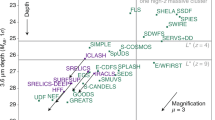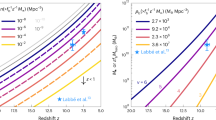Abstract
DIRAC1 suggested in 1937 that the gravitational ‘constant’ G might vary with time. This idea has since been used in several cosmologies, particularly those of Hoyle and Narlikar2 and those invoking the Brans-Dicke theory of gravity3. Limits to Ġhave been suggested by Barnothy and Tinsley4 from the observed form of the redshift–magnitude relation and by Dearborn and Schramm5 from the existence of clusters. Nevertheless, Van Flandern6 has provided substantial observational support for a secular decrease in G such that Ġ/G = −(7.5±2.7)×10−11 yr−1, and this is supported by Morrison and Ward's7 work on the transits of Mercury. The idea deserves to be explored further, pragmatically in non-cosmological contexts, but we are here primarily concerned with the explanation it affords for the ‘missing mass’ paradox.
This is a preview of subscription content, access via your institution
Access options
Subscribe to this journal
Receive 51 print issues and online access
$199.00 per year
only $3.90 per issue
Buy this article
- Purchase on Springer Link
- Instant access to full article PDF
Prices may be subject to local taxes which are calculated during checkout
Similar content being viewed by others
References
Dirac, P. A. M., Nature, 139, 323 (1937).
Hoyle, F., and Narlikar, J. V., Mon. Not. R. astr. Soc., 155, 305 (1972).
Dicke, R. H., Rev. Mod. Phys., 34, 110 (1962).
Barnothy, J. M., and Tinsley, B. M., Astrophys. J., 182, 343 (1973).
Dearborn, D. S., and Schramm, D. N., Nature, 247, 441 (1974).
Van Flandern, T. C., Mon. Not. R. astr. Soc., 170, 333 (1975).
Morrison, L. V., and Ward, C. G., Mon. Not. R. astr. Soc., 173, 183 (1975).
Vinti, J. P., Mon. Not. R. astr. Soc., 169, 417 (1974).
Collatz, L., The Numerical Treatment of Differential Equations, 3rd ed., 69 (Springer, Berlin, 1951).
Rood, H. J., Rothman, V. C. A., and Turnrose, B. E., Astrophys. J., 162, 411 (1970).
Holmberg, E., Arkiv. Astr., 5, 305 (1969).
Lewis, B. M., and Robinson, B. J., Astr. Astrophys., 23, 295 (1973).
Arp, H. C., Nature, 225, 1033 (1970).
Rood, H. J., Page, T. L., Kintner, E. C., and King, I. R., Astrophys. J., 175, 627 (1972).
Poveda, A., Iturriaga, R., and Orozco, I., Boln. Observs. Tonantzntla Tacuba, 20, 3 (1960).
King, I. R., Astr. J., 71, 64 (1966).
Brandt, J. C., and Roosen, R. G., Astrophys. J., Lett., 156, L59 (1969).
Sandage, A., Astrophys. J., 178, 1 (1972).
Lynden-Bell, D., Mon. Not. R. astr. Soc., 136, 101 (1967).
Reddish, V. C., Mon. Not. astr. Soc., 170, 261 (1975).
Turner, E. L., and Gott, J. R., Astrophys. J., Lett., 197, L89 (1975).
Chincarini, G., and Rood, H. J., Nature, 257, 294 (1975).
Author information
Authors and Affiliations
Rights and permissions
About this article
Cite this article
LEWIS, B. Variable G: a solution to the missing mass problem. Nature 261, 302–304 (1976). https://doi.org/10.1038/261302a0
Received:
Accepted:
Published:
Issue Date:
DOI: https://doi.org/10.1038/261302a0
This article is cited by
-
Evolution of dynamical systems with time-varying gravity
Nature (1977)
-
Time-varying Newtonian gravity and universal motion
Nature (1976)
Comments
By submitting a comment you agree to abide by our Terms and Community Guidelines. If you find something abusive or that does not comply with our terms or guidelines please flag it as inappropriate.



